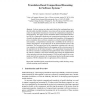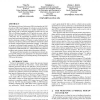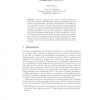FM
2003
Springer
14 years 7 months ago
2003
Springer
Software systems are often model checked by translating them into a directly model-checkable formalism. Any serious software system requires application of compositional reasoning ...
ASP
2003
Springer
14 years 7 months ago
2003
Springer
It is commonly believed that the meaning of a formal declarative knowledge representation language is determined by its formal semantics. This is not quite so. This paper shows an...
ISPDC
2003
IEEE
14 years 7 months ago
2003
IEEE
Many formal modelling notations for business processes have been proposed during the last decade. They can be broadly classified into high-level visual notations, with an intuiti...
ASM
2004
ASM
14 years 7 months ago
2004
ASM
Abstract. Static single assignment (SSA) form is the intermediate representation of choice in modern optimizing compilers for which no formal semantics has been stated yet. To prov...
SWS
2004
ACM
14 years 7 months ago
2004
ACM
The Platform for Privacy Preferences (P3P), developed by the W3C, provides an XML-based language for websites to encode their datacollection and data-use practices in a machine-re...
XSYM
2005
Springer
14 years 7 months ago
2005
Springer
Abstract. Recently it was shown that existing general-purpose inductive logic programming systems are useful for learning wrappers (known as L-wrappers) to extract data from HTML d...
VMCAI
2005
Springer
14 years 7 months ago
2005
Springer
Interval computations, stochastic arithmetic, automatic differentiation, etc.: much work is currently done to estimate and to improve the numerical accuracy of programs but few c...
ASWEC
2005
IEEE
14 years 8 months ago
2005
IEEE
Message Sequence Charts (MSCs) are a graphical language for scenarios of communicating components exchanging messages in a distributed environment. The language has been standardi...
KI
2007
Springer
14 years 8 months ago
2007
Springer
Abstract. The aim of this paper is to present a formal semantics inspired by the notion of Mental Imagery, largely researched in Cognitive Science and Experimental Psychology, that...
TOOLS
2008
IEEE
14 years 8 months ago
2008
IEEE
Abstract. Many real-time systems use runtime structural reconfiguration mechanisms based on dynamic creation and destruction of components. To support such features, UML-RT provid...



